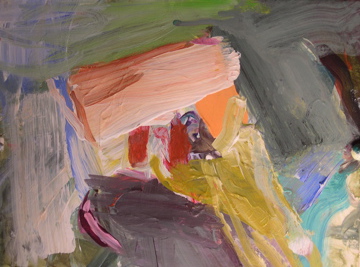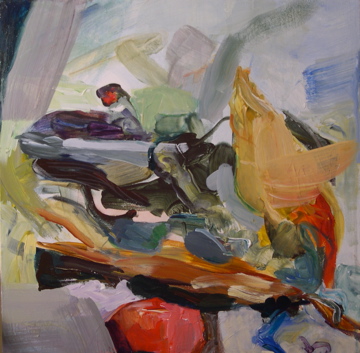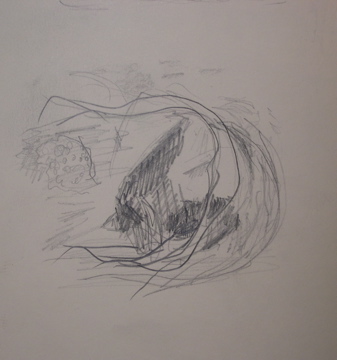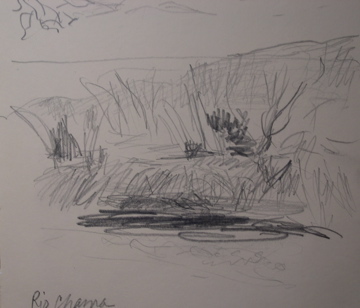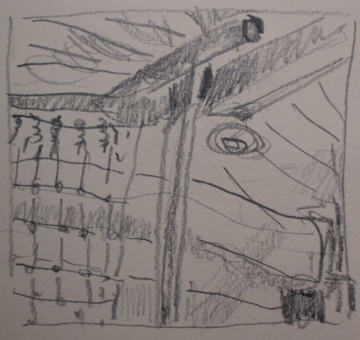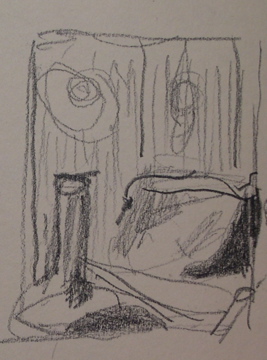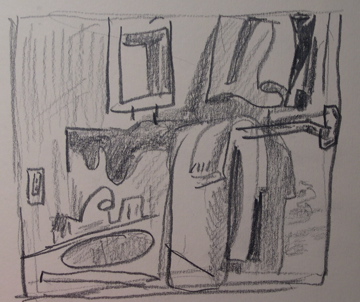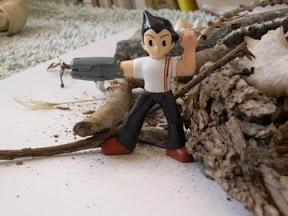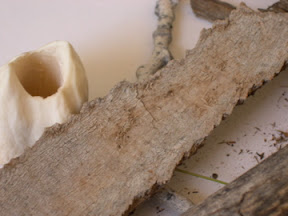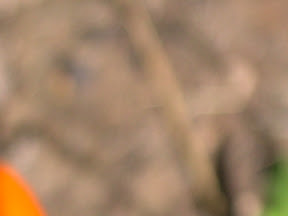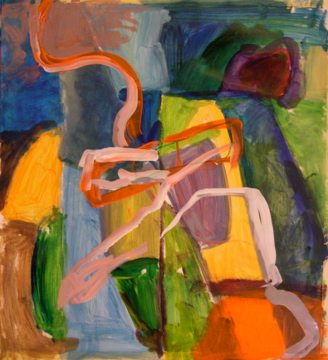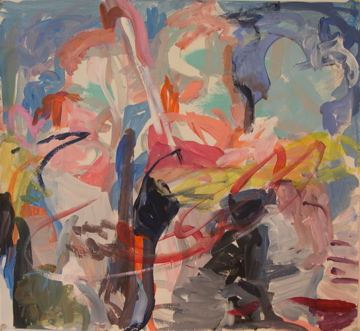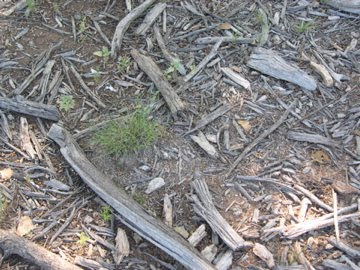Jill Christian
Advisor: Laurel Sparks
Semester 1 Summary
1 December 2009
Semester 1 Summary – Mixed BagsThis first semester has, I think, been successful, but not in any way I’d imagined back in June. I left the first residency with enthusiasm, planning to complete at least 12 paintings (I envisioned large). I was going to set up arbitrary rules and use a timer to force myself to switch brushes, colors, or techniques. I was going to work on a single painting for 30-days, and see what happened to myself and the painting over time. I was going to experiment with scale, proportions, distortion, and asymmetry. Instead, I experienced a series of frustrating dead-ends and blocks. And so I’ve returned to working smaller and on “the basics” of painting. This has led to a bit of a break through and I anticipate working this way for the next several months, and into next semester.
The first two months of the semester I began three large canvases, each exploring three different ideas. I had on my mind not only to shake up my mark-making, but to explore my “idiosyncrasies” – a recommendation from the residency. Specifically, I set out to explore what I found attractive in Baroque painting, selecting an image of a Rubens painting to examine and use as a jumping off point. I also stumbled upon a book of Indian Miniatures and decided to explore these color schemes (I later read that Amy Sillman also points to this source as an early influence in color choice). At the same time, I started working off of photographs of flowers and plants – specifically from my recent trip to Kauai.
One result was my “30-day painting.” It began as a painting of an abstracted flower. Then, I introduced elements taken from a photo of bathers on a beach. On top of that, I painted forms referencing an Indian miniature. It became a bit unruly. I found this painting particularly frustrating because it felt new every time I worked on it. I wasn’t sure where it was going, other than it would last for 30-days. The most successful of the larger paintings was the one based on the Rubens painting. I have for now put aside these three paintings as well as the larger format.
I discovered in late August, with my mentor’s help, that I had taken on multiple projects, and that I was still working in the same way as before: fast, all-over compositions, all on the surface mark-making, and unresolved color. She felt that I might be better off focusing on technical issues, working smaller, and restricting myself in subject matter. She recommended that I work on painting fundamentals. Specific issues that need to be addressed are: color; figure/ground and spatial relationships; subject matter/source material; the ability to sustain a painting over multiple painting sessions; recognizing when a painting is working or not working; and being realistic about personal time and energy constraints.
I tried (though I rebelled frequently) to work in a reduced palette. I stopped even trying to make paintings. I switched to working on paper and did a number of really small, quick abstract color studies – just colors and shapes.
A breakthrough came with three events: I took a two-day color theory workshop, I wrote a paper that focused on the role subject matter plays in the work of several artists I’m interested in, and I decided to focus on painting sticks. After witnessing me working from a ton of different reference materials – mostly photographs – my mentor and I thought that it would be best to paint from a primary source – ideally from nature. And, noticing that many artists set up projects for themselves (i.e., Amy Sillman drawing couples for the work that ended up in her Third Person Singular exhibit), I began collecting sticks. I’ve been doing a lot of walking in the Bosque along the Rio Grande, and I’m fascinated by the shimmery grays and golden hues in these broken, piled up Cottonwood branches scattered in the woods. There’s a subtle beauty in the colors resulting from varied states of desiccation and sun-and-weather fade. More than anything, the connection with nature re-energized me, and finding a single thing to paint felt like a lifeline.
So, finally in this last month I feel that I’ve hit on a subject that will allow me to paint “something” while working on technical issues of color and pictorial space. I began a number of 12x12” studies of the sticks that I will continue through December. I think that working in this way will do two things: allow me to work quickly and complete a number of paintings—which I find satisfying; and also really explore this subject matter. I also am trying out painting on artist panels, and I have found that I like working on the hard, smooth surface – a surprise. On the first pass, there is almost a sense of there being a resist on the surface, and there’s an opportunity to work with underglazes before I begin putting down thick strokes. It was recommended that I try oils; but after a couple muddy attempts, I’ve decided to stay with what I know for awhile. One thing that has intrigued me is that these little studies of stick piles end up looking like landscapes. I like the idea of a part, closely-focused, resembling the whole.
In these studies, my mentor has suggested that I work on my color vocabulary – really look at the colors in the grays and spend time mixing and selecting color schemes. I am also going to try different painting tools and vary the surface qualities. Another commitment is to spend more time on each painting. This continues to be a major stumbling block for me. I have a real palpable distaste for going back. I like to work quickly and move on. My mentor suggested that I need to learn to recognize the problems that need to be worked out in a painting, and to know when it’s “finished”. I am getting a sense that I have a need to “discharge” some kind of energy as I work. I spend a lot of time in my head, thinking about things, and then I shoot them out. I am experimenting with giving myself permission to do quick one-offs on paper, if I need a break. I may need to find a way to work this almost physiological need into my studio practice at the same time I learn to work longer on a painting and to go back and edit.
My reading this semester has been all about abstract painting (though I have been reading a bit in more general areas as well). A recurring theme to critiques of my work is that it seems to be an “adaptation of a pre-existing style”, rather than a result of an inquiry. Though I do understand this conceptually, when I look at any one specific painting, what this looks like and means becomes less clear. So, I’ve been finding more contemporary references (beyond De Kooning, Mitchell, and Pollock) in order to start to think more expansively about what abstract painting can be about--to understand abstract painting as more than a style that continually refers back to the 1920s to 1970s (in my case specifically to New York school abstract expressionism). My major challenge with the reading is that I want to read everything. Like with my painting, I can tend to get a number of texts going at the same time, and I would like to be more focused and disciplined, particularly with making sure that I take time to write summaries of the readings. I particularly struggled with Briony Fer’s On Abstract Art. As I was reading, it made sense, but I have difficulty re-articulating her major points. I found a “critical reading worksheet for texts from art and theory” from an art history course, and I am going to use it to organize my reading and note-taking.
Two things that I find very challenging with the low-residency MFA program are pacing the work and the lack of peer interaction. On my agenda for next semester (see footnote) is to be more disciplined with scheduling the work I need to do each month. At the beginning of the semester, I had a very difficult time working 40 hours at my office, parenting, and getting in the minimum hours for the MFA program. In September, I negotiated a 32-hour work-week with my employer. This has made a huge difference. Still, I feel like I am adjusting to find the right scheduling rhythm. I have been looking for ways to meet other artists and students. Taking the color theory class helped. The teacher offered to help introduce me to other art students and through her I heard about graduate reviews at The University of New Mexico. I connected with two students and we’re looking for a time to get together after the holidays. I also want to see more exhibits locally. This can be challenging given my current schedule, but remains a goal for next semester.
FootnoteList of things to work on and improve for next semester:Collection of tear sheets from magazines, books, or fabric that have palettes that interest me, with attention to the ratio of warm to cool, light to dark, vivid to muted in these palettes / do some studies based on these.
Journal. Looking back, I wish that I had more consistently journaled after each day of painting. I have lots of scraps of paper that I wrote notes on, but I feel being more systematic and organized would be very helpful. I am going to begin to do this now at the end of the semester, and continue it through next semester.
Struggle with “going back”. I paint intensely for a while and then really don’t want to go back to the same painting. Trying out the 30-day painting was challenging, because it really became a different painting every time – different shapes, colors, ideas. I found it to be exhausting and draining. It might be interesting to try this again, but smaller and using a very specific source.
Refer back to notes and my agenda. This can serve as a kind of “beacon” for me. I need to allow for spontaneity, discovery, and change, but I have a strong tendency to move quickly from one thing to the next, and my mind is always busy. The thing to watch for is the tendency to move on before I can fully explore something, or decisively decide to abandon it for something else. I’ve been doing some career coaching, which involved some pretty extensive aptitude testing. I tested quite high in “idea flow” and “diagnostic reasoning”. These two things combine to make me apt to move from one thing to the next (jack of all trades, master of none) and to be highly self-critical. I need to keep aware of this and make sure to note my successes. Goals and agenda are a good tool for this.
Commentary/suggestions from Laurel: “I just want to emphasize that intuition plays a very strong role for many abstract painters. Keep trusting your instincts, while taking more time to reflect upon what you have done. Let the work be your teacher at the same time as you impose structure.”
“…Continue mining the topic of what it means to be making abstract expressionist paintings in 2009. The premise for the UCLA Hammer show Oranges and Sardines is based on dialogue among contemporary abstract painters and their influences. If you haven't picked up the book from that show, I strongly encourage you to do so.”
“Focus directly on the painting process and allow meaning and content to emerge in retrospect. Imposing subject matter can often restrict the work before it ever gets the chance to BE anything.”
BIBLIOGRAPHYArtists ResearchedDaniel Brice
Cecily Brown
Mary Heilmann
Udo Noger
Jackson Pollock
Amy Sillman
Charline von Heyl
Books readAshton, Dore. Cecily Brown/Des Moines Art Center Catalogue. New York: Rizzoli International Publications Inc, 2008. Print.
Batchelor, David, Chromophobia.
Dimand, Maurice. Indian Miniatures. New York: Crown Publishers/The Folio Art Books, ?year. Print.
Elkins, James. What Painting Is.
Emmerling, Leonhard. Jackson Pollock 1912-1956: At the Limit of Painting,. Koln: TASCHEN, 2009. Print.
Garrels, Gary. Oranges and Sardines: Conversations on Abstract Painting (exhibition catalog). Los Angeles: Hammer Museum, 2008. Print.
Gibson, Add Eden. Abstract Expressionism: Other Politics.
Howard Hodgkin, Nicolas Serota ed.
Jackson Pollock: New Approaches, Kirk Varnedoe ed.
John Currin Selects. Boston: MFA Publications, 2003.
Perry, Vicky. Abstract Painting: Concepts and Techniques. New York: Watson-Guptill Publications, 2007. Print.
Schwabsky, Barry. Vitamin P: New Perspectives in Painting.
Scribner III, Charles. Rubens. New York: Harry N. Abrams Inc., 1989. Print.
Tuchmann, Maurice, et. al. The Impact of Chaim Soutine (1893-1943): De Kooning, Pollock, Dubuffet, Bacon. Galerie Gmurzynska. ISBN 377579103.
Varnedoe, Kirk. Pictures of Nothing.
The Abstract Impulse: 50 Years of Abstraction at the National Academy, 1956-2006, Marshall N. Price
Books in process
Bois, Yve-Alain. Painting as Model.
Fer, Briony. On Abstract Art.
Rosenthal, Mark. Abstraction in the Twentieth Century: Total Risk, Freedom, Discipline. New York: Guggenheim Museum, 1996. Print.
“Want to read”Art History Versus Aesthetics. James Elkins, ed.
Nickas, Bob. Painting Abstraction: New Elements in Abstract Painting.
Godfrey, Tony. Painting Today.
Krauss, Rosalind. The Originality of the Avant-Garde and Other Myths.
Elkins, James. Why Art Cannot Be Taught.
Sarup, Madan. An Introductory Guide to Post-Structuralism and Postmodernism.
Storey, John. Cultural Theory and Popular Culture: A Reader.
Storey, John. Cultural Theory and Popular Culture: An Introduction.
Albers Josef. Interaction of Color.
Mayer, Musa. Night Studio: A Memoir of Philip Guston. New York: Da Capo Press.1997. Print.
Ashton, Dore. American Art Since 1945. New York: Oxford University Press, 1982.
Articles (partial list)Barliant, Claire and Christopher Turner. “Painting Paradox.” Modern Painters, Summer 2009.
Bell, Kirsty. “It’s Own Reality.” Frieze, May 2009: 92-97 Print.
Green, Tyler. Modern Art Notes: Amy Sillman at the Hirshhorn. Web. http://www.artsjournal.com/man/2008/04/amy_sillman_at_the_hirshorn.html.
Rubenstein Raphael. “Provisional Painting”. Art in America, May 2009 122-135.
Letham Jonathan. “The Ecstasy of Influence: A Plagiarism.” Harper’s Magazine, 59-71.
Von Heyl, Charline. “1000 Words: Charline von Heyl Talks About Sabotage, 2008.” ArtForum, October 2009: 330-339. Print.
Videos/Documentaries/DiscussionsAlice Neel
Art 21 (Seasons 1 and 2)
Ayers, Leslie. “Graduate Review.” University of New Mexico, Albuquerque. 6 Nov. 2009. Discussion.
Hammer series; Oranges and Sardines
Heilmann, Mary. Art: 21 - Mary Heilmann. PBS. Web. 1 Nov. 2009.
.
Sillman, Amy. “A Conversation with Amy Sillman.” Hirshhorn podcast. Web. 25 Oct. 2009.
.
Exhibits
Albuquerque Now, The Albuquerque Museum
Udo Noger, Gerbert Contemporary
Daniel Brice, Chiaroscuro Gallery
Phillis Ideal, Chiaroscuro Gallery
Magazines
Modern Painters
Art in America
Harper’s

